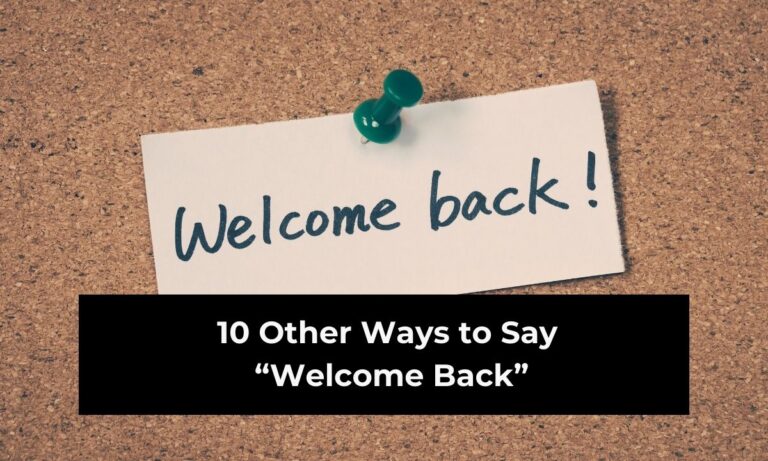You’ve finished writing an email, a project proposal, or maybe even a heartfelt letter, and now you’re at the very end. You want to invite feedback, but typing “Please let me know what you think” feels… overused. It’s a reliable phrase, sure, but it’s not exactly memorable.
When you communicate—whether it’s with a colleague, client, friend, or family member—you’re not just exchanging information. You’re building connection, showing personality, and shaping how others see you. That final line of your message is more than a formality; it’s an opportunity to leave a lasting impression.
The truth is, people respond better when your request for feedback feels warm, tailored, and human. Instead of the same standard line, you can use alternatives that sound more natural, engaging, and true to your voice. The right closing can make someone want to respond—not just feel obligated.
This is especially important in today’s fast-paced communication world. People skim messages, pick up the tone instantly, and decide whether to reply in seconds. If your closing feels personal and approachable, you’ve just made it that much easier for them to hit “Reply.”

In this article, you’ll discover 10 creative, professional, and friendly alternatives to “Please let me know what you think.” Each one is designed to help you sound confident yet approachable, whether you’re writing for work or personal matters. You’ll also see how to adapt each phrase to different contexts, so your closing always fits the tone you’re going for.
By the end, you’ll have a go-to collection of phrases you can use anytime you want feedback—without sounding repetitive or dull.
1. I’d Love to Hear Your Thoughts
This option feels warm and inviting. “Love” adds a touch of personal interest, showing the other person that their opinion truly matters to you.
You might use this when you want to create a friendly, open tone—perfect for conversations with coworkers you know well, clients you have a good relationship with, or friends giving personal advice. It avoids sounding pushy while still encouraging a reply.
The beauty of this phrase is that it’s flexible. You can use it in both casual and professional contexts simply by adjusting the rest of your email’s tone. If the message is formal, pair it with a professional greeting and sign-off. If it’s casual, you can leave it just as it is.
Here’s an example:
“I’ve outlined the initial design concepts in the attached file. I’d love to hear your thoughts on which direction feels best before we move forward.”
This approach works well because it frames feedback as something you’re eager to receive, not something they’re obligated to give. It subtly conveys respect for their perspective, making them more likely to share it.
2. What Are Your Impressions?
This phrase has a thoughtful and conversational tone. Instead of directly asking for an opinion, you’re inviting the other person to share their first reactions—whether positive, neutral, or critical.
It’s a great choice when you want to avoid sounding too formal but still keep things professional. “Impressions” focuses on the bigger picture, which is especially useful in creative, marketing, or design-related conversations where gut reactions matter.
You might write:
“I’ve put together a few mood board options for the upcoming campaign. What are your impressions? Do any stand out to you?”
The phrase works well because it opens the door to both immediate feedback and deeper thoughts. It doesn’t demand a detailed response but leaves room for one if they want to elaborate.
It’s also effective in situations where you genuinely want honest, unfiltered feedback. By asking for impressions rather than conclusions, you make it easier for people to speak freely.
3. I’m Curious to Know Your Take
Curiosity is a powerful motivator. By saying “I’m curious,” you make your request sound more like a genuine interest than an obligation. This can help the other person feel valued rather than pressured.
This phrase is excellent when you’re discussing something that has multiple valid perspectives, like strategic decisions, creative concepts, or collaborative projects.
For example:
“After reviewing the market research results, I’m curious to know your take. Do you think we should adjust our approach?”
It works because “your take” feels casual and personal—it’s as if you’re inviting a conversation rather than asking for a formal evaluation. This is ideal for building rapport, especially in teams where open dialogue is encouraged.
If you want to make it even warmer, you can combine it with a compliment: “I really value your insight, and I’m curious to know your take.” This shows you’re not just fishing for responses—you’re genuinely seeking their expertise.
4. Could You Share Your Perspective?
This phrase puts emphasis on the uniqueness of the other person’s viewpoint. It’s more formal than some of the earlier options, making it a strong choice for professional communications, especially with clients, supervisors, or new contacts.
By using “perspective,” you acknowledge that their feedback isn’t just information—it’s informed by their background, experience, and expertise.
Example:
“We’ve compiled the latest sales trends for the quarter. Could you share your perspective on how this aligns with our overall strategy?”
The tone is respectful and collaborative, which can make the recipient more willing to engage thoughtfully. It avoids sounding demanding, instead positioning the request as part of a mutual exchange of ideas.
This phrase works particularly well in settings where decision-making benefits from multiple viewpoints, such as planning sessions, brainstorming meetings, or advisory roles.
5. I’d Appreciate Your Feedback
Direct, polite, and professional—this is one of the most timeless ways to request input. The word “appreciate” signals gratitude in advance, which can soften the request and encourage a positive response.
This phrase is well-suited for situations where you want to remain concise but still convey respect. It can be used across all forms of communication, from quick internal messages to formal proposals.
Example:
“Here’s the revised project outline based on our last discussion. I’d appreciate your feedback before we lock in the final version.”
The reason this phrase works so well is because it’s short yet courteous. It acknowledges the other person’s time and effort, making it more likely they’ll respond quickly.
If you want to make it warmer, you can add a small note about why their feedback matters: “I’d appreciate your feedback—it always helps me see things from a fresh angle.”
6. What Do You Think About This?
Sometimes, simple is best. This straightforward question feels natural, as if you’re asking it in everyday conversation. It’s especially effective in informal settings or when you’ve already established a comfortable rapport.
Example:
“I’ve drafted a few taglines for the product launch. What do you think about this one?”
Its conversational tone makes it easy for the other person to respond quickly, without overthinking. It’s a friendly nudge for feedback rather than a formal request.
However, because it’s so casual, you might want to avoid using it in highly formal emails or with new contacts. In those cases, a more polished option would be better.
Still, when you want an approachable and easygoing vibe, this phrase is perfect—it gets straight to the point while keeping the door wide open for honest opinions.
7. I Value Your Insight
This is one of the most affirming ways to request feedback. It doesn’t just ask for input—it tells the other person their thoughts are important and respected.
It’s particularly effective in professional settings where the recipient’s expertise is clear. Whether they’re a mentor, manager, or experienced peer, this phrase communicates trust in their judgment.
Example:
“We’re exploring a few new workflow options for the team. I value your insight on what might work best for everyone.”
By framing your request this way, you’re not only asking for information—you’re building goodwill. People are more likely to share thoughtful responses when they feel their opinion is valued.
8. How Does This Sound to You?
This phrase adds a collaborative tone. It suggests you’re open to making changes and want to make sure your idea aligns with theirs.
It’s especially useful in team settings where mutual agreement is important. The phrase also works well when suggesting a plan or solution and you want to check if it feels right to the other person.
Example:
“I’ve adjusted the meeting schedule to free up our afternoons for deep work. How does this sound to you?”
The key here is that it frames feedback as a shared decision, not just a personal request. This helps foster cooperation and reduces the feeling of being “evaluated.”
9. Would Love Your Honest Opinion
This phrase invites sincerity and openness. By specifically asking for an “honest opinion,” you encourage the other person to share their real thoughts—even if they’re critical.
It’s a good choice when you’re confident in your work but open to improvement. It can also build trust, as it shows you’re not afraid of constructive feedback.
Example:
“Here’s the new website layout draft. Would love your honest opinion—does it feel user-friendly enough?”
The word “honest” reassures the other person that you value truth over politeness, which can lead to more meaningful responses.
10. Can’t Wait to Hear What You Think
Energetic and enthusiastic, this phrase adds excitement to your request for feedback. It’s a great choice when you’re genuinely eager to hear the other person’s thoughts.
Example:
“I’ve recorded a demo of the new feature. Can’t wait to hear what you think once you’ve tried it out.”
This closing works well in casual or semi-formal settings, especially when you want your enthusiasm to be contagious. It also creates a sense of anticipation, which can prompt quicker replies.
Conclusion
Asking for feedback doesn’t have to feel stiff or repetitive. By switching up your closing phrases, you can make your messages more engaging, personal, and effective. Each of the alternatives here offers its own nuance—some feel formal and respectful, others casual and warm. The key is matching the phrase to your relationship with the recipient and the tone of your message.
When you show genuine curiosity, express gratitude in advance, or convey enthusiasm, you invite more meaningful responses. And when you acknowledge someone’s expertise or perspective, you strengthen your connection with them.
Next time you’re about to type “Please let me know what you think,” try one of these alternatives instead. You’ll keep your communication fresh, encourage richer feedback, and make the other person feel truly heard.
FAQs
1. Why should I avoid overusing “Please let me know what you think”?
Because repetition can make your requests sound routine and less personal, reducing the likelihood of an engaged response.
2. Can I use these alternatives in formal emails?
Yes. Options like “I’d appreciate your feedback” and “Could you share your perspective?” work perfectly in professional contexts.
3. Which alternative is best for casual messages?
“What do you think about this?” or “Can’t wait to hear what you think” are great for informal conversations.
4. How can I make my feedback requests more engaging?
Use warm, personal language, show genuine interest, and acknowledge the recipient’s expertise.
5. Should I combine these phrases with a thank-you?
Absolutely. A quick “Thanks in advance” or “I appreciate your time” can boost response rates.





